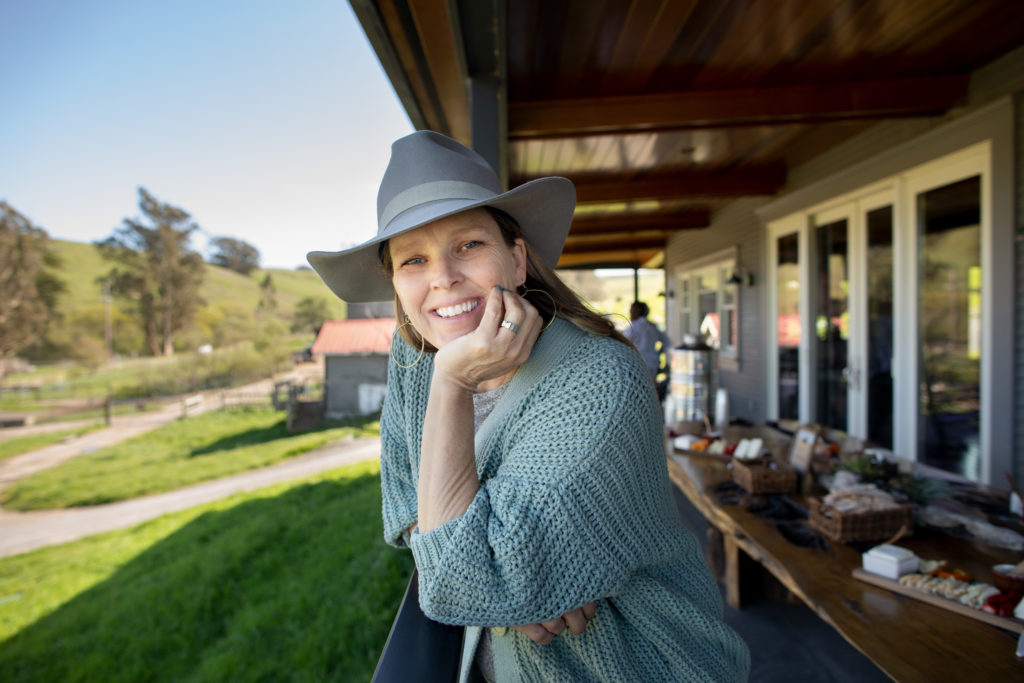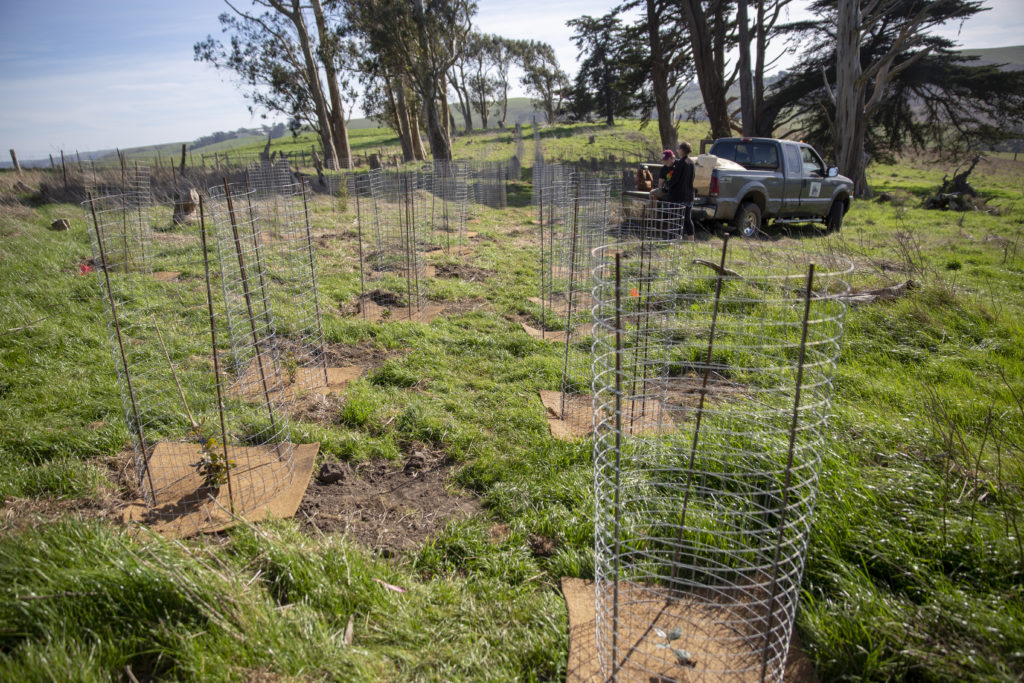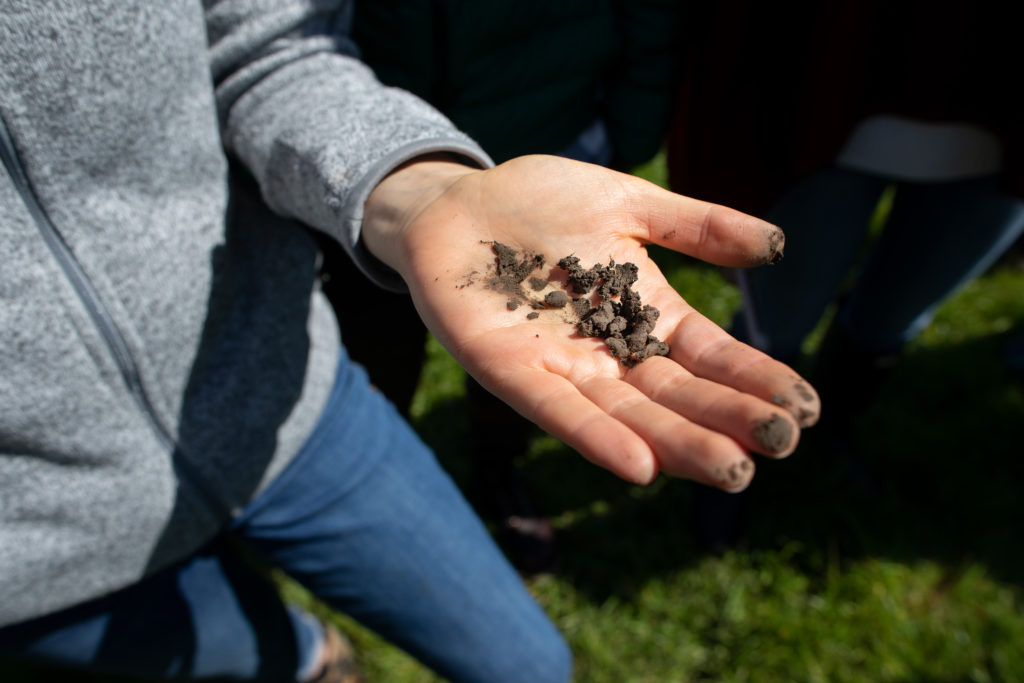Stewardship Spotlight: Planting Windbreaks at Toluma Farms!
May 7, 2020
In late February, five-hundred plants went into the ground along a windswept ridgeline above Toluma Farms. A heroic community effort involving complex planning, enthusiastic volunteers and a cohort of local agency partners, this project is an important one for this beautiful place.
Toluma Farms, MALT protected since 2010, can be found just west of the town of Tomales. The lower part of this ranch is home to a historic barn, a milking parlor and a creamery building where owners Tamara Hicks and David Jablons and their amazing team manage a sheep and goat dairy and an on-site farmstead creamery. Up the very-nearly-vertical ranch road are windswept pastures, where this farm’s sheep and goats are rotated regularly to graze and browse.
Since purchasing this farm in 2003, Tamara and David have worked with MALT and local organizations to carry out important land stewardship projects. They also recently opened Daily Driver in San Francisco where they, along with partners Hadley and David Kreitz and Martin Siggins, make cheese and butter using milk from MALT-protected Thornton Ranch.
For Tamara and David, producing and selling amazing cheese is only one of their many goals. They also aim to make their farm as productive as possible, improve the health of the land and sequester as much CO2 as possible through their management practices.
 Tamara Hicks of Toluma Farms
Tamara Hicks of Toluma Farms
Over the years, they have restored the creeks and drainages that bisect this farm, providing wildlife habitat while helping the land hold on to more water, and have improved their grazing rotation to stimulate plant growth and increase the carbon in their soil.
In 2015, Toluma Farms was selected by the Marin Carbon Project for the development of a Carbon Farm Plan.
The completed plan outlines numerous projects specifically designed for this ranch to sequester CO2. But knowing where to start, how best to implement these projects and how to pay for them is a challenge in and of itself.
With technical support from MALT’s Jonathan Wachter, and funding from the California Department of Food and Agriculture’s Healthy Soils Program and the California State Coastal Conservancy, Tamara and David are ticking off one big carbon farm plan project after another. Aiming to implement the highest-impact projects first — in terms of both climate benefits and increased land productivity — last year they strategically spread compost on an upland pasture in order to stimulate forage growth and increase carbon sequestration in the soil.
This February, they completed another gargantuan carbon farming project: planting 500 trees, shrubs and grasses along two ridgelines near the top of the ranch. Made up of a variety of local shrubs and trees, such as Monterey cypress, California coffeeberry, coast silk tassel and more, together the two windbreaks are a quarter-mile in length! When they are fully grown, the windbreaks will look very different from the historic windbreaks you see today, those tall lines of cypress and eucalyptus trees. These windbreaks’ diverse native trees and shrubs, each of which will grow to different heights, will do a better job of blocking out the wind, while providing pollinators with flowers and wildlife with habitat.
 Plants in the ground at Toluma Farms, complete with protective deer caging.
Plants in the ground at Toluma Farms, complete with protective deer caging.
Over the next 50 years and more, these windbreaks will help fight climate change, too. The woody trunks will lock up carbon from the atmosphere and, because of their strategic locations on the farm, they will protect downwind pastures from drying out, allowing for forage to grow later into our dry summers. Which, in turn, increases the pastures’ productivity while building more carbon in the soil.
This windbreak planting project has been a team effort by Tamara and David, the Marin Resource Conservation District, STRAW (Students and Teachers Restoring A Watershed, part of Point Blue Conservation Science), the Carbon Cycle Institute and MALT.
Together, we can do this!

Why Carbon Farming Matters
In our changing climate, carbon farming is crucial. With improved management, soil across the United States could sequester up to 430 million metric tons of carbon per year — that’s a little less than a quarter of this country’s annual greenhouse gas emissions.